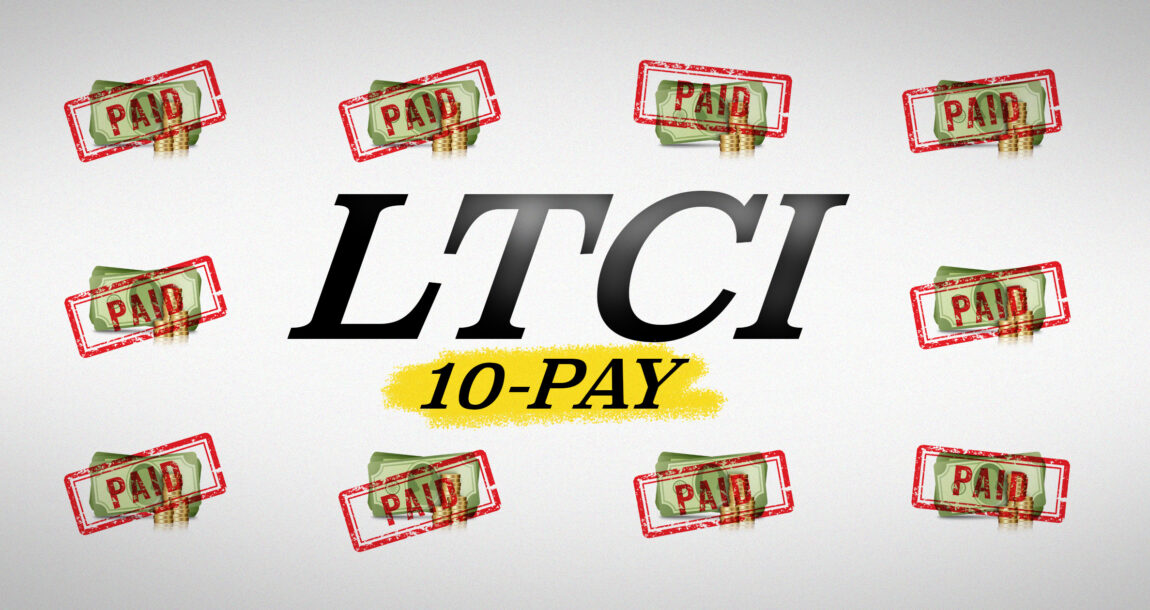Why 10-pay LTCi could be a smart move

As a large portion of the U.S. population ages, difficult decisions about long-term care insurance and its various products will take center stage in many families. Whether someone is considering a traditional or hybrid LTCi policy, there are some basic choices to make. The primary considerations include what the benefits will look like when care may be needed, the initial monthly LTC benefit, total benefit pool and inflation protection.

However, another essential decision centers on determining how to pay for it. Families can consider different payment options, such as annual lifetime-pay plans, single-pay plans or the increasingly popular 10-pay premium plan. One key benefit of 10-pay plans, applicable to both traditional LTCi and hybrid plans, is that premiums are guaranteed never to increase during the payment period. This feature provides certainty and peace of mind, ensuring that policyholders know exactly what they will pay.
Tax advantages for individuals
Depending on the policyholder’s age, a portion of the LTCi premium may be tax-deductible. Self-employed business owners can deduct a portion of the LTCi premiums for themselves and their spouses each year, and individuals can use health savings account dollars to pay for a portion of the premiums. These tax advantages make LTCi more affordable.
Premiums are paid during high earnings years
With plans that include built-in inflation protection, benefits continue to increase while no additional premiums are due after the 10-year payment period. This allows policyholders to invest during their high-earning years and enjoy the benefits later without incurring additional costs.
Investment flexibility compared to single premiums
The initial premium outlay for a 10-pay plan is significantly less than a single-premium plan. This allows policyholders to invest their savings with more risk tolerance, knowing that their LTC plan is in place and paid for within a decade.
Benefits for C-corporations
C-corporations can pay premiums on behalf of a select group of executives, offering substantial tax benefits. This feature is particularly advantageous for family businesses looking to provide valuable benefits to key members. The premiums for LTCi are simply subject to reasonable compensation, so often the entire annual premium can be deductible.
Using qualified savings to fund an LTCi plan
For people over the age of 59 1/2 who have a large percentage of their savings in qualified funds such as 401(k)s, there are options that involve purchasing a single premium qualified annuity that will fund a 10-pay LTCi policy. The premiums count as required minimum distribution. The distributions will be taxed annually, but the whole process is automatic and provides great peace of mind and protection for existing retirement assets.
Selecting and recommending an LTCi solution
After a 10-pay option is considered, an advisor must help a client narrow down a proposed solution. Because 10-pay plans are health underwritten, a critical first step is to perform a preliminary underwriting inquiry. This will help narrow down or eliminate carrier choices and save valuable time.
Next, a pricing and benefit comparison can be conducted. Sometimes premiums can be very similar, so there will be other reasons for selecting a carrier - such as how they pay for home care, if they cover international benefits or how the return of premium features works.
As an example, consider a couple, both aged 50, who purchase a joint life/LTCi plan with 10-pay premiums of $10,000 annually. This plan provides an initial total benefit of $350,000 and $4,500 per month for care. The benefits chosen will increase by 3% compounded annually. By the time the couple reaches 85, the benefit will be close to $1 million with a monthly LTC maximum near $11,000. The total premium outlay will be $100,000, offering immediate leverage for LTC at a factor of 3.5 growing to 10X at older ages.
A 10-pay LTCi plan offers several advantages, including guaranteed premiums, tax benefits and the ability to pay premiums during high-earning years. It provides flexibility in investment and has specific benefits for C-corporations. By choosing a 10-pay plan, policyholders can ensure they are well-prepared for the future while enjoying the financial benefits today.
© Entire contents copyright 2025 by InsuranceNewsNet.com Inc. All rights reserved. No part of this article may be reprinted without the expressed written consent from InsuranceNewsNet.com.
Tom Riekse, CLU, ChFC, is the managing director of LTCI Partners, an NFP company. Tom may be contacted at [email protected].




State Street study looks at why AUM in model portfolios is increasing
Lincoln Financial execs hail strong annuity sales; life business in ‘transition’
Advisor News
- Social Security retroactive payments go out to more than 1M
- What you need to know to find success with women investors
- Senator Gary Dahms criticizes Governor Walz's proposed insurance tax increase
- Social Security staff cuts could ‘significantly impact’ beneficiaries
- Building your business with generative AI
More Advisor NewsAnnuity News
Life Insurance News
Property and Casualty News
- Food Liability Insurance Program (FLIP) Introduces Monthly Payment Option for Liquor Liability Insurance
- $27 million of $28M 'Jane Doe' settlement to come from JC city funds
- Porch Group Announces Four Seasoned Industry Leaders Strengthen the Organization
- Is a joint insurance policy a bigger step than saying ‘I love you?’
- Ask a Trooper: Car seat replacement…
More Property and Casualty News